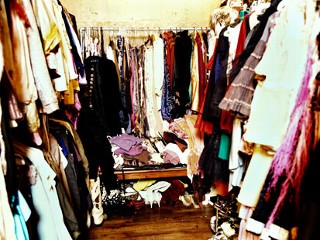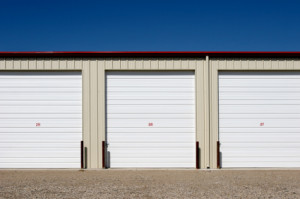
Is your closet a mess? Check out these tips to help you get organized!
By Relocation.com
Storage can be small to almost non-existent in a small apartment. Your closet, whether it is used for clothes or other things, is mean to keep things in place and out of sight in order to keep your room clutter free. However, most people just pile their things into a closet, without thought of what it looks like. It is important to keep the inside of your closet neat as well. You’ll be able to keep your things neat and clean, as well as maximize your space so you can fit more inside. Here are a few tips so you can get started on getting your closet organized.
1) Clear it out.
If your closet is so full you can barely close it, then it’s time to get rid of some things. The easiest way is to start emptying your closet and placing things in piles or boxes – those things you should keep and things you should give away. Be impartial and practical when you decide on what to keep and get rid of. If you haven’t worn it in a year, chances are you’ll never wear it again. If you’re waiting to lose those 10 pounds to fit into your old jeans – don’t! Give it away and buy new, slimmer jeans if (or when) you do lose that extra weight.
2) Use every inch of your closet.
Are you using every available bit of space inside your closet? Shelving is important to make use of vertical space, and if you don’t have any built it, you can easily find stacking shelves that you can place inside so you can fit more items in. Look as every nook and cranny to find ways to add more storage. How about the closet doors? You can attach hooks to your closet door and hang shoes, scarves, belts, ties and bags.
3) Organize visually.
Use your eyes to organize. What does this mean? First, you should keep the things you need often at eye level, so you can easily get to them without disturbing the closet’s organization. Next, organize things by color. That way, if you’re looking for a particular red shirt or yellow dress, your eyes will be drawn to that particular corner of your closet and you can quickly get to it. The same can be said of organizing shoes. Keep them in clear boxes so you know what’s inside, or else, take a photo and place it outside the box so you know which is which.
With these organizational tips, you can easily maximize your closet space and keep your things in order. With a neater and orderly closet, you’ll be able to access the things you need easily and keep you space from being cluttered, which may also make moving that much easier.

Consider these storage solutions for your small space.
By Stephen Davis
Special to Relocation.com
When your space is limited in your new apartment or dorm room, you may end up wondering just where to put stuff so that you don’t end up with tons of clutter. Luckily, there are some pretty and creative ways to store things. It just takes some time and imagination.
The first thing you can do is to evaluate your belongings. If there are items that you really don’t need, get rid of them. You only want to store the things you really need and want and all the rest is just useless clutter.
Think vertically. Once you have cleaned out the useless stuff, it is time to take a look around at just where you can be creative. One thing you can do is to think vertically. Try a bookcase that reaches the ceiling, for instance. You can display a lot on a floor to ceiling bookcase; everything from books to photo albums, magazines and knick-knacks can be put on those shelves. Consider a tall bookcase as a headboard for your bed.
Use the inside of closet and cabinet doors. You can buy plastic hanging shoe-holders, for instance, and put a ton of stuff into them. In the kitchen you can even store small containers, utensils or spices in them. In the bathroom you can roll up towels and put into those pockets, or spare toiletries. For the bathroom, a small wine rack can hold a lot of towels and washcloths as well.
Use storage underneath. Another space you can utilize is under the coffee table or end tables. Get nice looking containers that will fit under these, or try using steamer trunks. You can even use trunks as your coffee table! Look under things for available space. Under the bed is a perfect place to store things, too. You can buy some boxes especially made for under a bed. In a child’s room, consider getting a captain’s bed that has drawers built into it.
Use hooks. In the kitchen, consider the use of hooks on the wall to hang pots and pans, strainers, utensils or whatever. Creatively arranged hooks can really look nice, and it will give you tons of storage. A pot holder that hangs from the ceiling is also a great space saver. Store food items like rice, cereal and the like in stacking plastic containers that take up a lot less room than the boxes the food comes in.
Consider items that double as storage. For instance, a foot stool or ottoman that has storage inside of it will be a great place to store things in. Using a small chest of drawers in the entryway can hold all your items like keys, umbrellas and things like that. You can even use a short chest of drawers as a coffee table! Install shelves high up on the walls of rooms to hold things.
Even the smallest of spaces can be maximized for storage. All you really need to think outside of the box and use some handy storage solutions (and your space) effectively.
Don’t forget to like us on Facebook and follow us on Twitter!
• Follow us on Twitter @Relocation_News
• Become a fan of Relocation.com on Facebook
December 31st, 2010 by
Admin
Categories:
design and decorate,
Do It Yourself,
exterior projects,
Holidays,
Home Improvement,
interior projects,
Moving,
Moving Day,
Moving Industry,
Storage Comments:
No Comments » 
Happy 2011! (Image Credit: AL.com)
By Serena Norr
It’s that time of year again; out with the old and in with the new. Part of that old might involve upgrading your home with a renovation or new design or throwing out your old clothes or moving to a new town or city – all exciting prospects that warrant a few pointers in the new year. As we say goodbye to 2010, we wish you the best of luck with your prospective change and have a few pointers to help you make your 2011 brighter, more exciting and more organized! Happy New Year from all of us at Relocation.com!
1. Moving in the New Year? Whether you are planning a big move across the country or a small move around the block, we advise planning ahead. All too often we hear stories of people scrambling for movers – only to use the first company that they find. We always advise researching three to five licensed moving companies from a reputable resource such as Relocation.com AND to have the movers come to your home for an in-house moving estimate. Taking estimates over the phone is a huge NO for 2011 – these prices are not binding and are subject to increase on moving day. Having movers come to your home allows them to see your belongings (thus determine the price) and this is also a great opportunity to ‘interview’ them – where you can ask them about anything from their insurance policy to how long they have been in the industry. No questions are off limits.
2. Decorating? Designing? Renovating? If you staying put you may want to spruce up your home with an exciting decorating project or an entire home renovation. No small feat, you should start by determine if the project is a necessity (leaky faucets) or a want (painting a room). The necessity should take precedence over the want and in some instances should only be handled by a professional. Be honest with yourself by what you can handle. You don’t want to start a huge project only to find out that you made a bigger mess that you started out with. As with finding a mover, meet with three to five contractors, architects or home improvement experts to discuss your project. They can also tell you how long they are expected to work in your home, what fees are involved and what the room will look after the project (if you designing). If it is a simple project, like painting, create a plan for yourself. Make a note of your budget, prospective color scheme and the estimated time line. Visit your local hardware store and bring home a few samples before you begin the job – also make sure to ask about what supplies you will need.
3. Out with the old in with the new. The New Year is a great time to get rid of some junk that you have been hoarding. Oftentimes we hold on to items that we no longer need or no longer realize that we even have. This turns into junk; leaving our homes filled with tons of useless stuff. Of course, some items are valuable or sentimental to us but still may not have a place in our homes. In those instances, consider keeping your belongings in a secure and climate-controlled storage facility. Going from room-to-room, evaluate your stuff by placing your items in a keep, toss or donate/store pile. Be honest with yourself about your needs vs. wants as well as your space restrictions. Items in the keep pile are necessities. Items in the toss and donate pile can be sold in a garage sale or donated to a local charity or to the Salvation Army.
4. Storage solutions. We are huge fans of storage – as mentioned above. This doesn’t only include housing your belongings in a self storage facility but placing your items in smaller organizational units to clear up some space. We love under-the-bed storage options such as this one from Bed Bath and Beyond and this modular closet system that organizes items in your closet. The kitchen and the bathroom are also major areas for clutter. Consider using roll-out under-cabinet drawers to contain and organize anything from products to dish towels.
Stick with your housing or moving resolution for 2011 – big or small – Relocation.com is here to help you every step of the way!
More Ideas for the New Year:
Don’t forget to like us on Facebook and follow us on Twitter!
• Follow us on Twitter @Relocation_News
• Become a fan of Relocation.com on Facebook

If you are using storage, be sure to purchase insurance!
By StorageFront.com
After you’ve rented a self storage unit, the first thing to consider is whether or not you need insurance.
At some facilities, it’s not an option; you have to have insurance. But if it’s not an option, you might look around and see the gate system and security camera and think your stuff is safe. But if you’re stuff is worth storing, it’s worth insuring.
Renters have three different options when it comes to insurance.
1. Sometimes homeowner’s or renter’s insurance will offer additional coverage to cover your storage unit (some plans will not cover anything once it’s removed from your home). This is often the cheapest option. If you plan to use this type of insurance, you need to make sure the facility where you are renting allows this as an option. When you go to rent, you need to make sure to take proof of insurance to the storage facility.
2. Some storage facilities offer their own insurance. The policies cover anywhere from $2,500 to $5,000. They may not require a deductible, but the rates maybe higher and coverage lower. It’s also important to ask what items the insurance will cover and what type of damage will be covered as well.
3. For more valuable storage, the best option might be to go with independent self storage insurance. These insurance companies might have a sort of partnership with the storage facility but operate independently. This type of insurance will insure higher-valued items and protect against damage that other insurance may not.
Insurance typically runs:
• $8 for $2,000 coverage
• $12 for $3,000 coverage
• $20 for $5,000 coverage
Some provide 50 percent burglary coverage for a cheaper rate. Jon Vogel is a Senior Account Executive at Bader Company, an independent self storage insurance provider. Vogel said he advises against getting the 50 percent burglary coverage.
“The only problem with that is our number one leading loss function is burglary,” Vogel said.
In case of burglary, Vogel suggests taking several measures to help guarantee that your claim will be processed if burglary occurs. Vogel said to use a disc or cylinder lock, which prevent many attempted burglaries. Bader Company waives the deductible if a renter uses a disk or cylinder lock.
When you put your storage inside your unit, Vogel said to take pictures of everything. If your valuables are stolen, take pictures of any damaged items and the damaged door. Vogel said to also keep everything and don’t throw anything away, even the lock. The insurance company will ask for some kind of proof of a break in, and the damaged lock should suffice.
As with any insurance, it’s important to understand the insurance that you’re getting and what is covered. Most facility managers are not certified to give advice or answer questions. Some public storage facilities in California have recently come under fire after offering advice and reportedly not processing claims.
“At no time is the facility manager an insurance agent,” Vogel said. “If you have questions specific to the insurance, most of them if they have gone through training with us will direct you to call us. No matter what insurance agent or company providing, there should be an 800 number. You should call insurance company.”
As with any insurance, the most important thing to remember is to do your research on the company, ask questions and get the rate that’s right for you. And don’t forget your camera to take pictures of the facility!
Looking for storage? Check out StorageFront.com for a local storage facility near you.